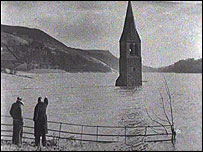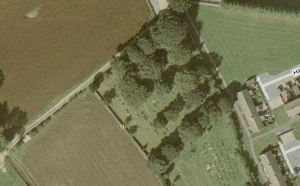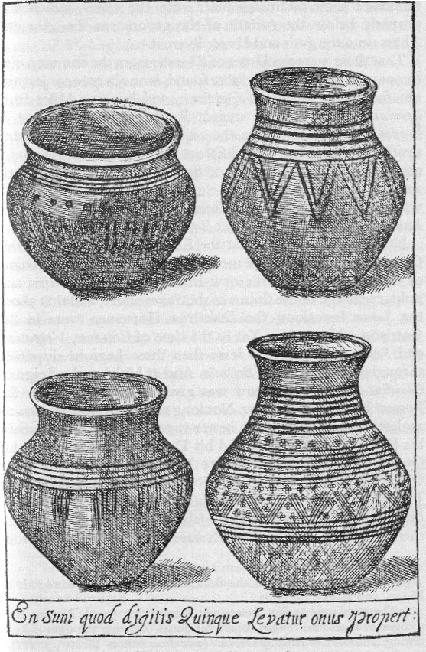Cribbing a title from the much-mourned David Markson, I really ought to get this blog breathing once more and start writing again. Writing salves the soul. I’ve written recently for a friend’s webpage, a guest-blog on the stunningly marginal topic of the current systemic problems within academia. As that was my former career, it is in any case something of a valediction. I’ll start writing things of greater social value here once the clouds clear.
12 August 2012
Last winter, in the frozen aftermath of not-a-great-Christmas, I took a bus out to the eastern shore of England’s coastline, where to stand at the edge of a country and to look out across slate-grey sea is to stare at nothing but elemental blankness all the way to Scandinavia. Here, at the very limits of the land, huddled towns and villages can be sought out, and seek I did, venturing north and east out to Whitby. I wanted to see the sea, and I couldn’t recall ever having been on that stretch of the Yorkshire’s coastline in the depths of midwinter; why not brave the cold, have a sea-side jolly? Feel worse to feel better (or vice versa?).
Whitby and its seashore are distinctly separated, geologically speaking, from the hills and vales of the rest of Yorkshire by a broad swathe of upland moor, land unsuitable for much in the way of habitation or arable agriculture. Scattered sheep apart, the relative featurelessness of the January moorland made even more startlingly prominent a large military installation at Fylingdales, a complex of buildings established at the height of The Cold War as a listening, tracking, early-warning station, checking on the progress of those always-just-about-to-arrive intercontinental warheads. When I was younger, the shape this took on the landscape was a short neat line of bright white geodesic domes, each shielding some mechanical whirligig from Yorkshire’s elements; today these have been replaced by a vastly silent pyramoid slab of (what appears to be) plastic, inside of which I imagine sit rows of ear-muffed screen-lit sentinels frantically scanning the soundscape for the tell-tale aural contrails of doom. But the bus-propelled travellers pay the spooks no mind, and we bustle down the hill to the sea.
There’s much good-natured rib-poking cultural banter about British coastal resorts out-of-season: chuckle-chuckle, could there be a more depressing sight than some near-abandoned rain-lashed place like Mablethorpe or Yarmouth or Margate in November or January or March, this is what being dead must be like, eh? Well, Whitby’s not at all like that. Mock me at your peril, it says, as soon as you’re off the bus. I may look good in summer, oh yes, but winter’s really where I’m at. This freezing wind, furrowing lines into your face from off the North Sea, this ceaseless mizzle, this remorseless cold, we were made for each other. Because Whitby’s not just the seaside, it’s the past.
Whitby goes way back. The Romans, as the security of their island province faltered, built a chain of look-out stations along this stretch of coast, sheltering the soldiers that scanned the sea’s horizon for the smudge of a sail perhaps bearing raiders. The first permanent settlement came in the mid seventh century when an Abbey was founded on the clifftop, presided over by St Hilda and sitting with the sea to one side and the deep valley of the River Esk to another. This lasted two centuries until it was razed by Danes, and the buildings lay in ruins for two hundred more years after that, until they were refounded by Normans in the eleventh century. For the next half a millennium Whitby bumped along pretty well as a small-scale fishing village, scratching its living from the sea, with the monks up top on the cliff-edge taking care of the post-living business: symbiosis. Then, in the sixteenth century, things began to change for Whitby. Henry VIII ordered the dissolution of all monastic houses after his break from the Catholic church, and above the village the Abbey relapsed to ruin; in the ground below it, valuable deposits of alum (a kind of potassic mineral used, among other things, as a fixative in the dyeing process) were found in the surrounding region. Thereafter, Whitby gradually moved away from medieval subsistence ways, and ever closer to the commercial, industrial, and the global. Its port, though never large, saw coal shipped in, alum shipped out, and whaling fleets embark for the Artic from its expanded harbour. Its geology, riddled with fossils, also disgorged jet, the mineralised remains of a forest of Jurassic monkey-puzzle trees, which was burnished and tooled into thousands of sets of Victorian mourning jewellery. And in the dying hours of the nineteenth century, in the mind of Bram Stoker, Whitby also saw the arrival of the doomed Russian schooner Demeter, embarked from Varna but adrift in a terrible storm with all hands seemingly lost and the Captain’s corpse lashed to the wheel. Goths flock to Whitby, famously, at Hallowe’en for their annual festival, thanks to Dracula’s fictive emergence from the Demeter’s hold; in the sparsely-touristed darkening autumn months, in fact, they’re the lifeblood of the place.
Climbing the immense flight of stone steps to the clifftop, on which sits not only the ruins of the Abbey but the still-very-much-alive parish church of St. Mary’s, Whitby feels not only high but deep. Its pasts go way down, but they also intercut, teaching anyone with an eye for their strata and their settlements (not to mention their cultural geography) that whilst patterns can repeat or rhyme across centuries, on other occasions the unpredictable can greet you out of the soil, spinning historical trajectories in unexpected directions. But in the churchyard of St. Mary’s there’s something else besides, because standing at the cliff-edge looking down into the deep cut of the river valley to the town below and across to the line of pale grey where the sky and sea meet, one is surrounded not by memory and its remembered pasts, but by its absence and all the pasts it forgot. Blackly silent gravestones cluster round, some curt and stolid like the cliff in which they’re planted, others licked by scallops and curlicues; close up, inevitably, high on earth’s exposed edge with the sea and the sand and the salt battering and grinding into their pores, most are mute, blind, dead. Some have had the skin of their inscription peeled clean away by the elements; others are puckered, leaving patterns of tactile knurls and whorls where the epitaphs once were cut. And then, ambling toward the church’s squat tower and awed by the banality of oblivion, there comes the realisation that what one took for the entirety of the churchyard is but a corner of a much larger field of the dead, as the stones file around a corner and away, around the church and beyond. The traces we leave behind, and how they inevitably fall away, are pretty much the trading stock in which Whitby deals. The classic existential day-trip to the sea-side.
Looking back on the last thirty years of cumulative scholarly endeavour made by those who – in the broadest way imaginable – study something of the past (no small task, that), broad trends can be discerned; fashions, movements, consensuses even, crossing disciplinary boundaries and cohering in pockets of theory. One of these has been an interest in memory (the memorious turn?): the avowal of its importance in the past, a resurgence of interest the work of the French sociologist Maurice Halbwachs in particular (who died in Buchenwald), and a commitment to take seriously how and why social groups collectively remember their pasts. More recently, some scholars and thinkers forged forwards with the concept of trauma, rather than simply memory, as a more suitable metaphor for examining the past’s relationship to the present: memory’s revenants, scars unhealed, horrors returning in our shared lucid dreams. Wider society has not escaped memory’s touch either: the last two decades has seen an extraordinary flowering of museological memory sites, many of them centred upon sites of unimaginable horror and cruelty (their nature and impacts admirably surveyed in Memorial museums: the global rush to commemorate atrocities, a monograph by Paul Williams). These “atrocity museums” (in Susan Sontag’s phrase) are inevitable reactions to our collective recoil as we survey the appalling human wreckage of modernity, especially in the last century: a litany of genocide, war, repression, starvation, shattered lives curtailed in pain and fear. To consign them to loss for their always would seem to bind us, complicit, to their ending. Rescued by memory, we reach back and in doing so attempt to affirm survival and transmission, ours and theirs. Memory at its most humane demands of us that we consensually avow in our souls that whilst looking back, though we see so many lost and fallen, we will strive to force those losses to render significance, tell a story, bestow meaning on our present. Memorials bid us do this, hoping to presume upon the present that somehow we onlookers will ensure that the echoes of loss are never silent, never stilled, and always supply truths, whatever they may be. Yet we, staring into the past’s staggering red void and reaching back gamely for those echoes, allow our eyes to be averted from the matching void ahead. When we are as dead as they are now, who will reach out to us?
The broken memorial, that Ozymandian punchline, is culturally familiar to us in the contemporary world. It has a certain ubiquity, even, as a metonym for the futility of seeking permanence beyond the bonds of life. Yet this ought not to desensitize us from its truth, especially when we seem to find ourselves gripped by a cultural fervour not only to memorialise everything, but also to make everything memory. Ought, in the face of this current memorial urge, the balance be restored and voices be raised to speak instead on the part of oblivion? Yet it is hard indeed to countenance the idea that oblivion might need someone to speak up for it, especially when it will all-too-inevitably silence the growing murmuration for remembrance with eventual ease, winning, as it does, every time: in the long run, everything is forgotten. Maybe there ought to be room within our proliferating memorial schemes for the inevitability of echoes silenced, traces erased? Standing in the freezing churchyard, then, one wonders how memorials can articulate their own transience. Can we mark true and irrevocable loss through something other than the lacunae in which the once-present-now-absent stood? In memory’s contemporary articulations, certainly not. We will not ever be reminded to forget, or be told that we will: the strutting bombast would wish us think that impossible, and remembrance’s claim to triumph endorsed. My feet wet and cold, I begin the walk back down the hillside, realising that memorials really don’t go in much for self-reflexivity. More to the point, perhaps, they don’t really ever need to.
Whitby, of course, is so prodigiously cavalier with its carelessly strewn metaphors of memory’s demise that they collectively slide towards cliché: a crumbling clifftop fertile with fossils washed away into the sea, vampires hoping for dissolute immortality but destined for dust, even a ruined abbey for heaven’s sake. The banality of so many, so many weathered markers, stacks up; a teetering pile so high and deep and wide to blot out any attempt we might make to enact loss. To speak of memory is to speak of forgetting because to speak at all speaks of loss. In A Short History of Decay, Emil Cioran (himself a Transylvanian, and born there only a decade or so after his compatriot, taking the form of a large black dog, washed up beside a Whitby breakwater) writes “Everything that deals with eternity inevitably turns into a commonplace…The notion of universal futility – more dangerous than any scourge – has been debased into the obvious: everyone acknowledges it, and no-one behaves accordingly”. We only have to see one fallen monument, one faded, stippled, obliterated epitaph, to see them all.
11 June 2009
Writing digging: archaeology and literature
Posted by hydatius under Books | Tags: archaeology, literature |[2] Comments
Several weeks ago I was fortunate to attend this event, a celebration of the life and work of J.L. Carr that was held at Shandy Hall¹, in Coxwold, North Yorkshire. An exhibition was opened which collected and displayed all of Carr’s idiosyncratic and aesthetically triumphant county maps of England, followed by an illustrated lecture given by Carr’s son (who currently oversees the publishing house his father founded) on the subject of J.L. Carr’s life and work. If the former has been detailed in some depth by a well-received biography, then the latter is usually truncated, in general, to the thoroughly outstanding novel A Month in the Country. Indeed I must admit, somewhat ashamedly, that at the time of writing it is the only one of his work’s I’ve encountered, apart from the array of county maps he created that were on display at Coxwold. A Month in the Country is probably as close to perfect as a novel can get: a tight, emotional, faultless evocation of loss and nostalgia, set within a beautifully sparse plot and informed by an unmatched eye for the sense of place and history in the English landscape². One thing that emerged of particular interest during the fascinating talk given in the evening was that Bob Carr, J.L. Carr’s son, had spent his working life as an archaeologist, with (I think) Suffolk County Council. I found this an immensely striking co-incidence, as A Month in the Country features a memorable cameo by an archaeologist, Moon, who is excavating in the field near to the church in which the novel’s main character, the art restorer Birkin, is rescuing a massive medieval Doom painting from beneath its whitewash overlay. Both are damaged veterans of the Flanders trenches, seeking some kind of healing or restitution.
Bob Carr’s job and Charles Moon’s trench propelled my thoughts towards other archaeologists in literature, and the role they might play in portrayals of the present’s relationship to the past. I’m well aware that there are a couple of streams of pre-existent thought on this topic. One of these is the investigation of the role of archaeology in science fiction/genre novels, where very frequently archaeology is a perfect vehicle for expressing aspects of the past’s malevolence and the ways in which, if disturbed, it can impinge upon the present. Archaeology, as task, also becomes the model of a ‘quest-narrative’ with the excitement of the chase and the past (or at least some artefact acting as its synecdochic stand-in) as the quarry. There is also a substantial amount of work on the place of archaeology in popular culture more generally (by Cornelius Holtorf in particular) centred in the main on the depiction of archaeologists in television documentaries and in mainstream cinema, but I was seeking examples culled from the novel, to sit alongside Charles Moon.
I know of the exhaustive list of archaeology in fiction, compiled by Anita Cohen-Williams, but my thoughts veered towards two books in particular, one on her list and one not: First Light by Peter Ackroyd, and Waiting for the Barbarians by J.M. Coetzee, both of which feature archaeology in a somewhat oblique manner³. The former is as bewildering, beautiful, and hallucinatory as the rest of Ackroyd’s fiction, and if one sidesteps some of the more Baroque renderings of rural antics, then one finds a deep meditation on the links between the landscape and the sky, the past and the future, archaeology and astronomy. In the latter, digging is hardly the Magistrate’s primary concern, but Coetzee shows how the archaeology that he pursues occasionally as a hobby informs his sense of self and his humanity; further, the awarenesses he gains from his excavations about the nature of time and the inevitability of its triumph colour his perception of the chain of events that forms the narrative’s core. In all three of these novels it is archaeology’s extraordinary fecundity as a symbol that surely draws the novelists towards it. Not only is it capable of being used to transmit metaphors concerning the presence of the past and its inevitable interaction with the Now, but it is also an investigative discipline that has an acute awareness of the landscape and our place in it, making marks that might be deciphered in centuries to come. Thus archaeology’s usefulness is its load-bearing capacity as supporter of metaphor, and that it works at illuminating the boundaries of things: past/present, people/landscape. Finally, no consideration of the cameo appearances of archaeology in literature can really be complete without reference to Borges, and to Tlön, Uqbar, Orbis Tertius in particular. Here, in a world in which idealist philosophy has triumphed over materialism, the archaeologists labour to ‘produce’ those objects they desire to find in their excavations. These hrönir are the artefacts spontaneously created by desire or subconscious need on the part of the excavators which have been of invaluable aid to the archaeologists of Tlön in modifying the past, “which is now no less plastic, no less malleable than the future”. Borges, as ever, is using the fantastic to tell us something we perhaps had scarcely perceived about the world in which we live, as our archaeologists ought not to need hrönir to tell them the truth of that.
——————————–
¹ Shandy Hall is quite one of the most astonishing and unique places you might ever visit, were you fortunate enough to happen by it: an extraordinary nexus of place, literature, and history. The carefully curated parsonage in which Lawrence Sterne created Tristram Shandy has been preserved not just as monument to the man and his work, but as a living exhibition devoted to the perpetually slippery relationships between text and life, books and thought. Oh, and it has some improbably beautiful gardens attached too.
² A more recent novel that shares most of these concerns and displays an almost equally adept handling of loss and landscape is Peter Hobbs ‘s The Short Day Dying, which is probably about as good a book as I’ve read in the past two or three years.
³ I know of two other novels in which archaeology features as the profession of the lead character, Briefing for a Descent into Hell by Doris Lessing and Out of this World by Graham Swift, although I have to admit not having read either. In any case, something interests me more in the three novels by Carr, Ackroyd, and Coetzee in the way archaeology is not the central issue in the narrative, nor even the main meaning-bearing metaphor, but something that is used, to a greater or lesser extent, to interact in a subtextual manner with the story’s broader interests.
31 December 2008
Between my finger and my thumb / The squat pen rests; as snug as a gun
Posted by hydatius under Books | Tags: billany, literature, workingclass |1 Comment
I wanted, very briefly, to write something about Dan Billany. My dashboard tells me that someone arrived at this blog via a Google search for his name; currently, he (and The Trap) are sitting in the sidebar, at the foot of my ‘Currently Reading and Recently Read’ widget. He has a good website dedicated to him, with detailed information about his life and work, and there is sufficient extra material available on the internet mentioning him more obliquely, so I hope that the Google searcher found what they were looking for.
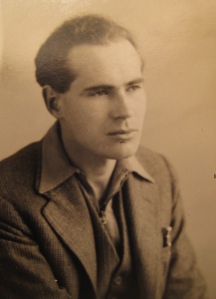
On any level, Billany’s was a remarkable life. A working class boy from the north of England at a time when that had serious social implications beyond the realms of cliché, he spent time during the 1930s unemployed and during this period a serious commitment to socialism began to manifest itself. Eventually, he trained to be a teacher and began to write fiction, but these embryonic careers were postponed by the outbreak of war. He fought in Africa and was captured by the Germans, eventually ending up interred in a prison camp in Italy. During his captivity he wrote two novels, The Trap and The Cage (the latter in collaboration with a fellow prisoner), and tried (apparently) to come to terms with his homosexuality. On the Italian withdrawal from the war the camp gates were opened, and Billany left and attempted to strike out for unoccupied territory. He handed the manuscripts of his two novels to an Italian farmer with instructions to mail them back to his family, and then he walked on, and out of history. His is a story without an ending, and his fate and his grave are both unknown.
I read The Trap recently, and it is an unusually good novel; judged as it stands, isolated from its backstory and context, it’s an astonishingly rich and detailed social document and a furiously angry novel about war. If one then considers the circumstances of its production, and the life its author had led up to that point (not to mention the poignancy of what was yet to happen), then it has to be one of the most remarkable narratives the war produced.
Because of the nature of the story, which follows a young lieutenant named Michael Carr from his life training in the infantry to the African theatre of war to eventual capture and incarceration (and thus we must assume a strong element of autobiography in the narrative), The Trap is partially a love-story, partially a political novel, and partially a book about war. What interested me most, though, was a pervasive sense that this was a book about working class identity, created in a most dire situation, that is being driven by the need to understand what that identity might mean when the existence of a working class literature was inchoate to say the least. I think what I find compelling, even more than this, is the image of narratives that explore the meaning of a working class and marginalised identity being produced in circumstances that either do not usually encourage such speculations, or elsewise actively inhibit them: there is a sense in The Trap that whilst war and captivity might be viewed as corrosively dehumanising, to think that the entirety of working class experience is any different risks self-delusion. Billany’s novel put me in mind of two other writers who both tried to do something similar in their own way: Patrick MacGill and Patrick McGeown.
MacGill was known as ‘the navvy poet’, born in rural Ireland 118 years ago tomorrow, who tramped around the Scottish countryside doing temporary manual labour here and there, was an autodidact, wrote and self-published poetry, and embarked upon a fairly astonishing career in fiction and journalism. I came to MacGill and his autobiographical first novel Children of the Dead End through McGeown, and I came to McGeown through a wonderful first-person piece that The New Statesman republished from its archive a couple of years ago. The book McGeown writes about having just finished did indeed get published, finding its way into print as Heat the Furnace Seven Times More, a fantastically apposite quotation from Daniel 3: 19, as the furious Nebuchadnezzar demands the stokers turn up the heat on Shadrach and pals. McGeown’s book is as remarkable as he makes it sound in his Statesman article; it stands not just as a reflection on the craft of making metal on an industrial scale in mid-twentieth century Britain, but it also speaks of how work shapes and creates a sense of working class identity, written in retirement by a man who had spent an entire life at the furnace edge.
The circumstances in which all three of these men produced their literature are wildly different, as are the books that they wrote, but to my eyes (northern eyes, eyes that saw a father and grandfather who made metal) they are held together by their narrative’s desire to try to articulate what it means to need to write, and to write about one’s own identity, when that very identity seems to discourage such speculative self-reflection. The very act of writing itself is a commentary on the nature of working class culture and identity, even before a single word has been written.
10 November 2008
And now I am become a burden that might be lifted with five fingers
Posted by hydatius under Thoughts | Tags: borges, browne, cremation, death, family, sebald |[2] Comments
The Sunday before last was All Soul’s, and in the cold and the wet that morning we scattered the ashes of my grandfather, who was ninety-four years old when he died in the very early morning of Christmas Eve. His funeral and cremation had followed his death as quickly as the festive season would allow, but what was left of him rested inside a plastic container with my mother; whilst the house clearing and selling were dealt with, it all seemed too soon still, but once the small house and its contents had been dispersed, it seemed right to do the same to him, and All Soul’s Day was as good a day as any. The site chosen was the place where the ashes of his wife, my grandmother, had been scattered six years earlier: atop the graves of her own parents, in the village in which she’d been baptised early last century. A view of the Cleveland Hills, in the quiet of a small village graveyard.
It was not a ceremonial moment: we were all family, and there was no-one to officiate but ourselves. Using trowels, we cleared away the stray grass and dead leaves in the lee of one of the pair of standing family gravestones, and then my mother opened the flask, and poured him out. We tried to bed the ash down, digging it into the soil, and in the mizzle there wasn’t much chance for him to be scattered, but that didn’t matter: we’d wanted him tight, fast to the earth, in the same spot as his wife had been similarly sown. A stout proud man, he’d been a sailor, an engineer, fought in the war, lived in Africa, and found his way home in the end. I was an archaeologist and I’ve dug many bodies, hating them every time for how they slowed me down and demanded care and attention to excavate and record, qualities I had little of as a trench-monkey. Here, though, was my grandfather’s cremated remains, and I was amazed at how much of him there was: not something to be flung from the fingertips like sand, but handfuls and handfuls, grey and black, shards and dust. And so we crouched there, turning this mound of powder into the damp ground, churning the charcoal-flecked ash with the soil from freshly-dug molehills next to the grave, bedding all that back into the earth.
Because I think too much, and most frequently about things that I shouldn’t, instead of standing solemnly and thinking about all the happy times I had had with my grandfather (not to mention how appropriate it was that he was uniting with the damp fertile soil when for most of the time I had known him he had so enjoyed producing flowers and vegetables out of his own small patch of it), I was instead mediating my feelings through others, thinking about the seventeenth-century doctor and philosopher Thomas Browne, and specifically about his essay on death and burial, Hydriotaphia, or Urne-Buriall. Browne’s inquiry into the social and cultural articulations of funerary custom was caused by the discovery of cremated human remains in North Norfolk.
In a Field of old Walsingham, not many months past, were digged up between fourty and fifty Urnes, deposited in dry and sandy soile, not a yard deep, not far from one another: Not all strictly of one figure, but most answering these described; some containing two pounds of bones, distinguishable in skulls, ribs, jawes, thighbones, and teeth, with fresh impressions of their combustion.
His study of human remains spins out into an exploration of materiality, the nature of historical knowability, the futility of remembrance, and the nature of being human. Browne is like no other writer, a fact that many other people have expressed better than I ever could, and Hydriotaphia is like no other work of literature I have ever come across.
I came to Browne for the very first time through Borges’ short story “Tlön, Uqbar, Orbis Tertius” (a piece I have already mentioned here, albeit pretty tangentially). I encountered Borges’ erudite name-dropping at a time when I was just beginning to grapple with the styles and processes of learning-as-task, and the mystical intricacies of esoteric names and books bleeding through the surface of the narrative delighted and aroused me in equal measure. Some names and works were known to me; others I assumed to be real, but I had yet to encounter them in my reading; a third category was revealed when I tried to find out more about Silas Haslam’s (non-existent) A General History of Labyrinths: those authors and volumes that Borges had invented for his narrative¹. I have little background in English literature, and at that point I had absolutely none in seventeenth-century literature of any kind, and thus the name of Sir Thomas Browne that makes a fleeting appearance at the end of Borges’ narrative was wholly unknown to me, and I was unable to discern which of the latter two categories he might belong to. Nor did I have any idea what a work of literature entitled ‘Urne-Buriall‘ might encompass (beyond the obvious), and I had absolutely no idea who Quevedo was. Then, in one of those particular co-incidences that in retrospect one re-examines and finds to be scarcely credible, I put down the volume of Borges short stories and picked up the next book on my to-read pile, The Rings of Saturn by W.G. Sebald. I read of the narrator’s desperate confinement in a Norwich hospital, and then in astonishment, of the tale of Thomas Browne’s skull, which had been interred in a church in that city upon his death in 1682, accidentally disinterred 150 years later, exhibited for display in the hospital museum, and finally restored to the ground in 1922². The remarks Sebald made about Browne’s works compelled me to seek them out, and upon returning to England in late summer of 2000 I finally got hold of an old copy of the Patrides 1977 collection for the Penguin Classics. I began, inevitably, with Hydriotaphia, and my obsession with his writing spiralled from there. I was fortunate to obtain other editions (including, most cherished, a gift of the six volume Keynes edition of the twenties). I visited the site of his grave, at St. Peter Mancroft in Norwich, and talked to the curate there who was kind enough to show me inside the vestry, and see the small collection of Browne relics(?) accumulated over the years, including his coffin-plate. I, like Sebald, followed the extraordinary odyssey of his skull, digging out of a neglected shelf a copy of the 1923 edition of the journal Biometrkia, wherein I found an extensive and thorough investigation of his cranial morphology. Another gift was a facsimile copy of the double portrait of he and his wife that is now in the collection of the NPG in London. Browne provided the epigraph of my doctoral thesis, and has managed to find his way into sufficent of my papers to have bemused those who know me.
Browne became an anchor for me at a time when it was far from clear whether or not I could make any sense from the material I was trying to collect and write about. It was to him I looked for a vindication that simple deep and wide reading could be a starting point in itself, that patterns (like the quincunx) might appear out if one collected and collated sufficient material, and that there should be no fear in traversing what appear to be defined disciplinary boundaries if you felt a strong enough urge to explore. His work further urged me to realise that the injection of the personal, the pulse of inquiry and wonderment, need not be discouraged if it could enlighten the narrative’s path. Unavoidably, Browne also taught me prose, and how to inhabit it, shape it, drive it, if not fully control or understand it. Writing, I turn again and again to Hydriotaphia, simply to read it and read it and read it. It lives, especially the final chapter, and it reaches unsurpassed heights.
The purpose of all of the greatest literature is to help us understand the journeys that we must make, those that are both inevitable and unique. Many times I’ve needed Browne, and read parts of his work over and over again³. Maybe then I shouldn’t have felt so bad that my grief over my grandfather’s death and the occasion of his commital to the earth and the wind was being refracted through the prism of Browne’s writings; articulations of loss are curious things, as Hydriotaphia itself tells us. Life is a pure flame, and we live by an invisible sun within us.
——————————–
¹ This was in an age before internet searches could be expected to point one towards reasonable information (or at least, it was beyond my capabilities to wring such information from the tubes). I looked Haslam up in the enormous green-bound catalogues at the university library where I was a graduate student. I note now that the relevant Wikipedia article gives a full list of the ‘fictive-ness’ of the story’s characters.
² It was something of a cascade of intertextuality, as Sebald not only describes Browne and his work in the first chapter of The Rings of Saturn, but he also manages a later reference to Tlön, Uqbar, Orbis Tertius and at the end of the third chapter replays Browne’s appearance in it.
³ Who, after all, has not needed “Men that look upon my outside, perusing only my condition, and fortunes, do err in my altitude; for I am above Atlas his shoulders”; I might as well get that as a frickin’ tattoo, as it’ll sit nicely alongside the chip on my shoulder.
24 October 2008
“Depression in trade also plays an important part in hurling the workers into the Abyss”
Posted by hydatius under Thoughts | Tags: economics, london, meltdown, poverty |[2] Comments
Within a day or so of the previous post, which treated our economic meltdown as something of a bagatelle in amongst various Borgesian mindwarpery, I felt as though I’d got my clock cleaned as I read a piece entitled Tips for New Paupers by John Dolan. Reading it made me feel as though I’d been kicked in the stomach by a cow, and I went on feeling that way for the next few days. It’s not as though I would even characterise my previous thoughts as flippant or derisive in their tone. Rather, they were motivated by trying to understand precisely why I felt so alienated by much of the media’s coverage of the crisis and how even though I was a participant-witness of ‘the meltdown’, I failed to feel part of any constituent whole to whom this was happening. Being unemployed, relatively transient, and without money, savings, or debts to speak of, this didn’t feel as though it was something that I was involved with, perhaps because much of what is taking place continues to reside in the realm of abstract money and has yet to fully filter down to the somatic economy (although unemployment, prices, and home repossessions climb gradually). Still, after reading the aforementioned piece any attempts towards the whimsical were knocked out of me sharpish.
The article is presented as an advice-piece written by someone (apparently a relatively peripatetic writer, editor, and academic) who has been recently been through a period of time in severe financial hardship; a year or so onwards, now things have become somewhat better for him, he reflects and tries to use the experience as a means of offering some counsel, as we all might be staring at a not dissimilar life-changing horror-time in the months ahead. At the most superficial level, my strong reaction to the piece was caused by the realisation that things could indeed get a great deal worse, and that acting as though I live in some ethereal big rock-candy mountain realm just because I don’t have a mortgage to default, a pension-plan that’s getting hosed, or a job to get shitcanned from, is some serious wishful thinking. He first describes “genteel” grad-student-type poverty (a place I’ve lived in [with the exception of a single six month period] continually for the past thirteen years), where you’re pretty perpetually cold through the winter, you eat mainly vegetables and pulses, and (most damagingly of all) you live on an edge of fear about how you’re going to manage and what you’ll be doing for food and heat in twelve month’s time. To anyone who has been a student of any kind, or even young at all, this is all pretty familiar stuff, but he’s concerned with the step down from that, into something altogether more serious and dangerous. This is where it gets so much worse for him, and where it can get worse for a lot of people (which is his point), and which, inevitably, includes me. Yeah, maybe we won’t all be the Joads, packing up every single small thing we have and moving great distances just to find work, but what made me sit up was realising that the step from the shabby “genteel” situation, to the dead-fuck-broke and seriously wondering about heat and food is a surprisingly small one.
In this respect, the article prompted me to recollect Jack London’s¹ The People of the Abyss²; not that I’m for a moment equating those desperate and bleak lives that London chronicles with any of our own more trifling worries — it’s simply that this tiny, imperceptible distance one travels to find oneself at a completely different level of poverty reminded me of the precariousness of the situation the book describes in the East End in 1902. In the book, London (incognito and in mufti) visits the slums in the East End, in order to try to produce a piece of reportage portraying the wretched lives of the working poor in London, a kind of ethnography of those who were being forsaken by capitalism and modernity. 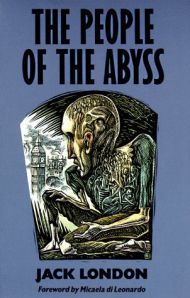
In what is a fairly harrowing book, there has always been one particular point that London stressed which I’ve found especially haunting: the precariousness of life. This is a recurrent theme but one to which London specifically turns for Chapter 21 (and from whence comes the title of the post). He described “the ragged edge of poverty”, upon which the vast majority of people live (both in the East End and beyond), whereby poverty is either already upon them or only at a single remove; for this latter group existence is such a matter of day-to-day survival that they inevitably have insufficient resources to stave off total ruin if more than a few days go by without income from work. Thus, it will only take a single unforeseen occurrence (injury, illness, bad luck, accident, or even unexpected economic downturn) to shatter an entire family and bring them all into the kind of abject workhouse pauperism that it can be impossible to escape from at all. Obviously it wasn’t the comparison of the actual states of poverty described in Dolan’s article that brought London’s book to mind: the people of the abyss are in far greater peril and misery than we of the developed world will ever see, no matter how sharp our current downturn is. Rather it was the image of teetering on the precipice which brought it to mind, particularly because (and this is why I wandered around for a while in a daze after reading the piece) it reminded me of me. Lately I have felt so very much as though I have stepped off a cliff without ever realising there was a cliff up ahead, or even noticing that I no longer trod on firm ground: only once I actually fell did I realise what happened. For the people of 1902 Whitechapel, of course, the difference is that the precariousness is of incredibly pitiless savagery, and that the faltering misstep or unexpected moment of bad fortune will not suck them any deeper into poverty (for they can fall no further) but will in fact leave them dead. I am still alive, but somehow have become unglued from an existence, and this is where Dolan’s article punched me out, I guess. Sometimes we end up where we do for good reasons, and more importantly, reasons that can be accurately retraced and understood as rational judgements with cause-and-effect; in other cases, you know you went wrong, but each incremental step of misjudgement never by itself adds up to a why. Even worse, sometimes each small step was, in and of itself, a right one (and sometimes the only right one), but added together in a narrative, they prove to be an inescapably logical trail of error. To crown it all, as Dolan so unflinchingly recounts, once you are in this state, you will frequently fail to identify and accept help when and if it presents itself.
“You change completely, more than you realize, to the point that even if you get a break you can’t grab it….I was too deeply, permanently spooked by our condition. I was just plain wrong….I was the wrong volume, the wrong temperature”.
Whether it’s being skull-fucked by depression for too long (meds never worked for me, unlike Dolan), too long living at that gray land where self-medication is beginning to shade into alcoholism, to full of uncertainty of self-worth, too deeply and perpetually ashamed. Maybe all of them. Maybe the reason that I even started the blog was to try to work some of this shit out. Sometimes you end up where you end up and you have no fucking clue how, and the line that you somehow somplace sometime crossed was one you didn’t notice, and every damn thing has come unhooked.
———————————————–
¹ I have a vast amount of love for London’s writing. Making a count for this post, I reckoned that I’d read about eight of his books and a volume of the best of his short stories. The last couple that I got ahold of (The Sea-Wolf and John Barleycorn) I started with some trepidation, fearing that the writing wouldn’t be as good as the others of his I’d already read. Sometimes I get this fear: loving a writer and starting off reading through most of their best-regarded work, and then perhaps being a little afraid to read farther into their wider body of writing, in case some of their more peripheral or minor stuff isn’t as hot and will somehow taint their original high standing. Whether or not this is a deeply stupid thing to worry about in general, in the case of London specifically I had nothing to fear: the former gripped like a wet rope, and the latter — whilst a little self-deluding — was a compelling description of what alcoholism feels like. I also realised that London is probably one of two writers that I have been reading for the longest. That is to say, I read Call of the Wild when I was pretty young, and I continued to read his work in my teenage years and all through my twenties, always keen to read ‘new’ books rather than re-reading ones I’d already been through. The other writer is J. Meade Faulkner: Moonfleet was probably my favourite novel as a kid, and recently I picked up a copy of The Lost Stradivarius, which was pretty good, and had an excellent introduction by Tom Paulin.
² The People of the Abyss I came to after The Iron Heel (the latter recommended to me by a friend who was more excited by Leon Trotsky’s piece that acted as the introduction); they both led me on into some astonishing contemporaneous works with similar socio-political concerns. One shared the hard-edged first-person sense of lives being lived with scarce hope and even scarcer money at the outer limits of early twentieth-century capitalism (The Children of the Dead End by Patrick McGill); another added furious demands for real political change to the overall image of a swathe of the population being brutalised by capitalist industry (The Jungle by Upton Sinclair); one in particular mutated the idea of a group of people with no way out into an astounding anarchistic fable describing the relentless brutality of the system (The Death Ship by B. Traven).
16 October 2008
To have no son, no wife, / No house or land still seemed quite natural.
Posted by hydatius under Thoughts | Tags: borges, economics, meltdown |Leave a Comment
Watching the ceaseless coverage of our global fiscal eschaton is somewhat disconcerting; the remorseless jeremiads against the markets/banks/John Q. Fatcat-Banker and the overall tone of impending megamoneypocalypse sit uneasily with my personal passivity. It’s like watching silently on your earth-bound monitor as grainy footage taken from inside the capsule shows the shaved monkeys somebody somewhere shot into space seventy-two hours earlier are slowly asphyxiating. Having almost nothing in assets of any kind, it is difficult to find a level of engagement beyond the abstract, and as the pretty numbers all shift into reds and minuses, I feel like an unhappy spectator, watching from the sidelines who fails to understand the horror of the crisis or the profound despair of those vanquished by Market Forces. There’s no smugness, for sure: I know this is real, and it’s serious, and it will doubtless impact on all of us somewhere along the line. It’s simply that I don’t have a dog in this fight (and as such, I felt an affinity with two recent posts by excellent bloggers), and so whilst I can feel pity, it’s empathy that is absent, and this results in almost complete disengagement.
And so, it came as some surprise when a recent newspaper Op-Ed piece about the economic crisis almost blew my head clean off my body as I was reading it. It begins by exploring the mysteries of global high finance, and the way in which transactions and their results have become so complicated and their articulations so esoteric, that explanations for why things happen are beginning to transcend normative statements of cause-and-effect. As such, it sits well alongside another recent insightful piece on the ‘faith-based’ economy by Arjun Appadurai, because subjective-seeming issues of belief and confidence begin to override the impact of apparently objective occurrences. And here’s where it gets weirder, because for the author — a guy named Richard Dooling — we are in danger of seeing those systems we initially created to monitor and calculate the multiplicites of the market’s rhizomatics actually take the fuck over. Accumulated capital has become so abstract and translocated that it has transcended our ability to understand it fully and much control must be ceded to a variety of technological apparatus in order to maintain some kind of equilibrium. This abstract marketplace then finds expression in ways that strike those not inside the machine as absurd or illogical, but our reality has become subordinate to the machine’s reality, and in order for the entire system not to come crashing down, we cannot turn the machine off. As I read further into the article (and here’s what caused the cranial asplosion), all I could think of was Tlön. We never needed a battalion of modest demiurgi secretly compiling the encyclopedia of a counterfeit world based on idealist imaginings; instead, it has been left to the financial logicians to create their subsequent and proximate macrocosmos, to which reality has immediately begun to yield with some relief. Thus, maybe disengagement is the inevitable answer to this, and the best thing is to pay no attention and go on revising my uncertain Quevedian translation of The Wealth of Nations (which I do not intend to publish). Or write my very first blog post.

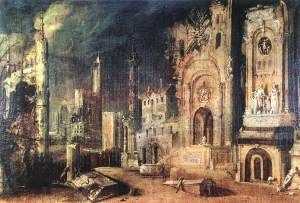 It seems impossible to understand the buildings as ever in use, nor do adjacent buildings seem to belong to the same age or the same urban language; maybe they were never even finished. Similarly, the people who inhabit these blighted scenes of fantasy do not appear to belong inside them: they seem engulfed not only by an architectural landscape that is unheimlich and atemporal, but they are also adrift and isolated from each other. This sense of uchronia in the static and miniaturised stances these people adopt is heightened by the fact that they frequently seem to be enacting scenes from Biblical narrative: moments from which specificity and uniqueness has been drained to be replaced by the omnitemporal suffocation of somatic allegories being rehearsed eternally. Desiderio achieves, to me at least, some kind of unparalleled aching malevolence in his articulation of the built landscape and its relationship to those who have become entrapped by it, and yet somehow, despite this, there remains some kind of exuberance in the depiction of these landscapes. The structures grow, tower, reach, spiral, collide, escape; in their forecourts we sleepwalk, trapped in dreams.
It seems impossible to understand the buildings as ever in use, nor do adjacent buildings seem to belong to the same age or the same urban language; maybe they were never even finished. Similarly, the people who inhabit these blighted scenes of fantasy do not appear to belong inside them: they seem engulfed not only by an architectural landscape that is unheimlich and atemporal, but they are also adrift and isolated from each other. This sense of uchronia in the static and miniaturised stances these people adopt is heightened by the fact that they frequently seem to be enacting scenes from Biblical narrative: moments from which specificity and uniqueness has been drained to be replaced by the omnitemporal suffocation of somatic allegories being rehearsed eternally. Desiderio achieves, to me at least, some kind of unparalleled aching malevolence in his articulation of the built landscape and its relationship to those who have become entrapped by it, and yet somehow, despite this, there remains some kind of exuberance in the depiction of these landscapes. The structures grow, tower, reach, spiral, collide, escape; in their forecourts we sleepwalk, trapped in dreams.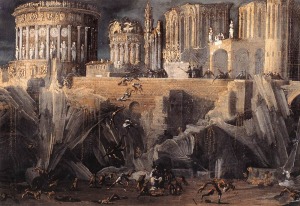
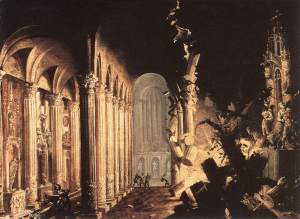
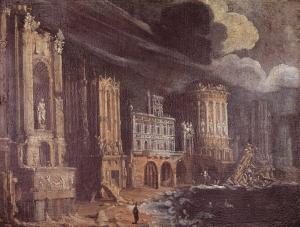
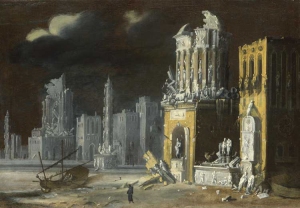 Why Augustine? For historians of medieval religion, there are lots of good reasons concerning the varying approaches to the relationship between religion and learning taken by the different monastic and mendicant orders from the mid-13th century onwards. Augustine, then, is a suitable candidate to be the figure in a cautionary tale concerning the inability of the human mind to comprehend the divine. I would, however, like to connect it with something slightly different; the medieval tale has always been for me a very faint echo of another encounter Augustine had with the incomprehensible by the sea, this time a moment of unimpeachable canonicity in his life, on the shore at Utica. In City of God
Why Augustine? For historians of medieval religion, there are lots of good reasons concerning the varying approaches to the relationship between religion and learning taken by the different monastic and mendicant orders from the mid-13th century onwards. Augustine, then, is a suitable candidate to be the figure in a cautionary tale concerning the inability of the human mind to comprehend the divine. I would, however, like to connect it with something slightly different; the medieval tale has always been for me a very faint echo of another encounter Augustine had with the incomprehensible by the sea, this time a moment of unimpeachable canonicity in his life, on the shore at Utica. In City of God 